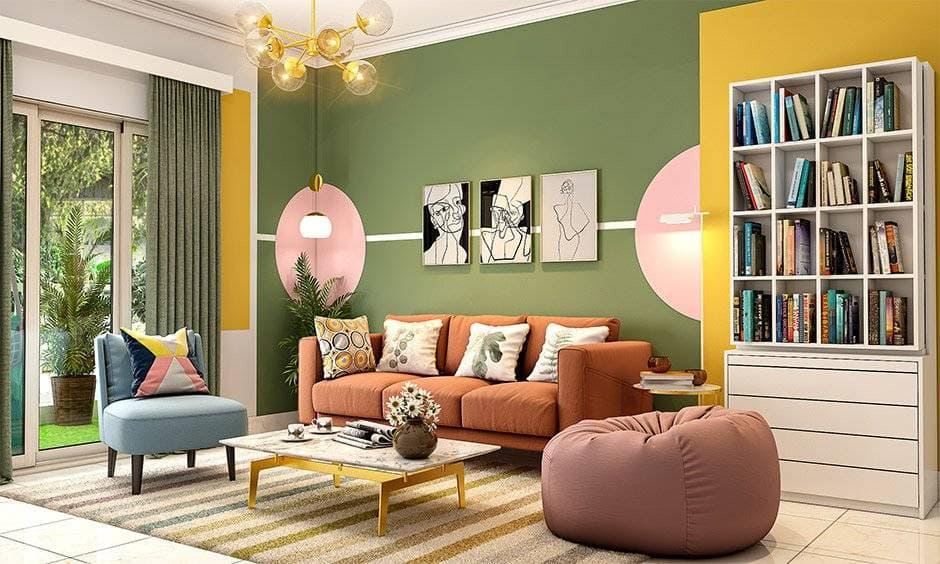The notion of a “futuristic” room often conjures images of sleek, high-tech environments with minimal clutter and a forward-thinking aesthetic. Today’s modern living spaces, however, are evolving into multifunctional hubs that seamlessly blend technology, sustainable materials, and innovative design—all while maintaining comfort and practicality. In this guide, we’ll explore the key elements that define futuristic room design and offer practical steps to transform any space into a vision of the future.
1. Understand the Essence of Futuristic Design
Futuristic design is about anticipating trends and rethinking the traditional notions of space, function, and aesthetics. At its core, it embraces:
-
Clean Lines and Minimalism: A pared-down aesthetic that emphasizes simplicity, clarity, and open spaces.
-
Innovative Materials: Use of modern materials like glass, metal, concrete, and even smart polymers that adapt to their environment.
-
High-Tech Integration: Seamless incorporation of smart home technologies and automation.
-
Sustainability: Eco-friendly materials and energy-efficient design solutions that are both futuristic and responsible.
-
Dynamic Lighting and Color: Use of LED lighting, bold accents, and a monochromatic base often punctuated with neon or metallic finishes.
By understanding these fundamentals, you can begin to envision a room that balances aesthetics with function.
2. Begin with a Clear Concept and Layout
Every successful design project starts with a well-defined concept. Consider the following steps:
-
Define Your Purpose: Is the room for living, working, or both? A futuristic home office might incorporate advanced tech and ergonomic furniture, while a living room might focus on integrated multimedia systems and ambient lighting.
-
Create a Floor Plan: Use digital tools or sketch a layout that emphasizes open space. A futuristic design favors a clean, unobstructed flow with designated zones for different activities.
-
Establish a Focal Point: Whether it’s a custom-built media wall or a statement piece of furniture, a clear focal point anchors the design.
A clear layout not only guides the overall design but also ensures that every element serves a purpose, reducing clutter and maintaining that futuristic minimalism.
3. Select a Futuristic Color Palette
Color plays a crucial role in evoking a sense of the future. Consider these approaches:
-
Neutral Base: Whites, grays, and blacks serve as an excellent backdrop. They create a timeless canvas that highlights other design elements.
-
Accents with Neon or Metallic Hues: Incorporate splashes of vibrant colors like electric blue, lime green, or neon orange to add energy. Metallic finishes in silver, chrome, or brushed nickel can also enhance the modern look.
-
Monochrome with Texture: A monochromatic palette can be enriched with textured materials such as matte surfaces paired with glossy accents.
Using a deliberate color palette helps unify the space and reinforces the clean, futuristic feel.
4. Integrate Smart Home Technology
Modern futuristic rooms leverage technology to enhance functionality and comfort. Some ideas include:
-
Automated Lighting: Install LED lighting systems that can change color temperature based on the time of day or mood. Options like Philips Hue or LIFX bulbs can be controlled via smart devices.
-
Voice-Activated Controls: Integrate systems such as Amazon Alexa or Google Home to control lighting, temperature, music, and more with simple voice commands.
-
Integrated Audio-Visual Systems: Conceal speakers, projectors, or smart TVs seamlessly within the design. For example, a motorized screen that retracts into the ceiling can transform a living space into a home theater at the push of a button.
-
Smart Thermostats and Security: Devices like Nest or Ecobee not only optimize comfort but also improve energy efficiency, while smart locks and surveillance systems add to your peace of mind.
By embedding technology into your design, your room will not only look futuristic but will also provide practical benefits that enhance modern living.
5. Choose Futuristic Furniture and Fixtures
Furniture in a futuristic room often pushes the boundaries of traditional design:
-
Modular and Multifunctional Pieces: Choose furniture that can be reconfigured as needed. Modular sofas, adjustable tables, and convertible workstations add versatility and adaptability.
-
Sleek, Geometric Forms: Look for pieces with bold, angular lines or curvilinear forms that defy conventional silhouettes. Minimalist designs with hidden storage can help maintain the uncluttered aesthetic.
-
Innovative Materials: Incorporate transparent or reflective materials like acrylic, tempered glass, or polished metal. These not only look modern but also help to bounce light around the room, enhancing the sense of space.
-
Ergonomics and Comfort: Even in a futuristic setting, comfort is paramount. Invest in ergonomically designed chairs and couches that support long periods of sitting without sacrificing style.
Selecting the right furniture is essential for creating a space that is both visually striking and comfortable for everyday use.
6. Emphasize Lighting as a Design Element
Lighting is one of the most transformative elements in any room, especially in futuristic design:
-
Layered Lighting: Use a combination of ambient, task, and accent lighting to create a dynamic atmosphere. Recessed lights can provide general illumination, while LED strips under furniture or along architectural lines add drama.
-
Interactive and Programmable Lighting: Consider systems that adjust automatically based on sensor inputs or user preferences. For example, lights that dim during movie nights or brighten during work hours can adapt the room’s mood instantly.
-
Statement Fixtures: Choose bold, sculptural light fixtures that double as works of art. Contemporary chandeliers or pendant lights in unconventional shapes can serve as eye-catching focal points.
With thoughtful lighting, you can dramatically alter the mood and function of your space while reinforcing the overall futuristic aesthetic.
7. Incorporate Sustainable and Biophilic Elements
Futuristic design is not just about high-tech; it’s increasingly about sustainability and reconnecting with nature:
-
Eco-Friendly Materials: Choose sustainable materials like reclaimed wood, recycled metal, or low-VOC paints. These materials not only reduce your environmental impact but also add unique textures and warmth to an otherwise sleek design.
-
Biophilic Design: Integrate elements of nature into your space. Vertical gardens, indoor plants, and natural light can soften the sterile feel of high-tech design. Living walls or planters integrated into furniture can bring life and energy to the room.
-
Energy Efficiency: Prioritize energy-efficient appliances, LED lighting, and smart thermostats. Sustainable design goes hand in hand with futuristic aesthetics, ensuring that your space is as responsible as it is innovative.
By incorporating green design principles, you create a room that feels not only modern and futuristic but also environmentally conscious—a critical consideration for today’s design sensibilities.
8. Add Unique Decor and Artistic Touches
While minimalism is a hallmark of futuristic design, personal expression is equally important:
-
Sculptural Art Pieces: Choose art that reflects innovation and modernity. Abstract sculptures, digital art installations, or kinetic art can serve as conversation pieces.
-
Tech-Inspired Decor: Items such as LED clocks, digital picture frames, or futuristic wall panels can enhance the theme. Consider artwork that incorporates elements of data visualization or digital abstraction.
-
Minimalist Accessories: Keep decorative objects to a minimum to avoid clutter. Instead, opt for a few carefully chosen items that reinforce your theme—such as metallic vases, sleek planters, or futuristic-inspired ceramics.
-
Customizable Features: Some designers now offer customizable decor elements that change with your mood or the time of day, like digital canvases that display rotating artwork.
A balance between minimalism and personalized decor will make your futuristic room not only a statement of style but also a reflection of your personality.
9. Practical Tips for a Futuristic Makeover
Before you begin a full-scale redesign, here are some practical tips to ensure your project runs smoothly:
-
Budget Wisely: Set a realistic budget that covers technology, furniture, decor, and professional services if needed. Consider phased renovations if you’re working with a tight budget.
-
Start with a Neutral Base: Paint walls in neutral tones to create a canvas that allows furniture and accent pieces to stand out.
-
Plan for Flexibility: Future-proof your design by choosing modular elements and technology that can be updated as innovations emerge.
-
Consult with Professionals: Interior designers who specialize in modern or futuristic design can offer invaluable insights and help you avoid common pitfalls.
-
Test and Iterate: Don’t be afraid to experiment with temporary changes. Use removable wallpaper, temporary lighting setups, or digital mock-ups to preview your ideas before committing.
By following these steps, you ensure that your futuristic room is not only visually stunning but also practical and adaptable to future needs.
10. Final Thoughts
Designing a futuristic rooms for modern living is an exciting journey that blends cutting-edge technology, innovative materials, and timeless aesthetics. Whether you’re drawn to clean lines, smart home automation, or sustainable design, the future of interior design lies in creating spaces that are as functional as they are inspirational.
Remember that the key to futuristic design is balance. While technology and modern materials are essential, they must coexist with comfort and practicality. A futuristic room should feel like a space where you can relax, work, entertain, and even evolve your design over time.
By embracing minimalism, incorporating smart technology, and adding personalized artistic touches, you can create a space that is uniquely yours—a room that looks ahead to the future while catering to the needs of modern living.
Take your time to experiment with different layouts, color schemes, and materials. As you do so, you’ll discover that the process of designing your futuristic room is as rewarding as the final product itself. In a rapidly changing world, a well-designed space that blends the best of technology and human creativity is not just stylish—it’s a sanctuary for innovation and inspiration.




